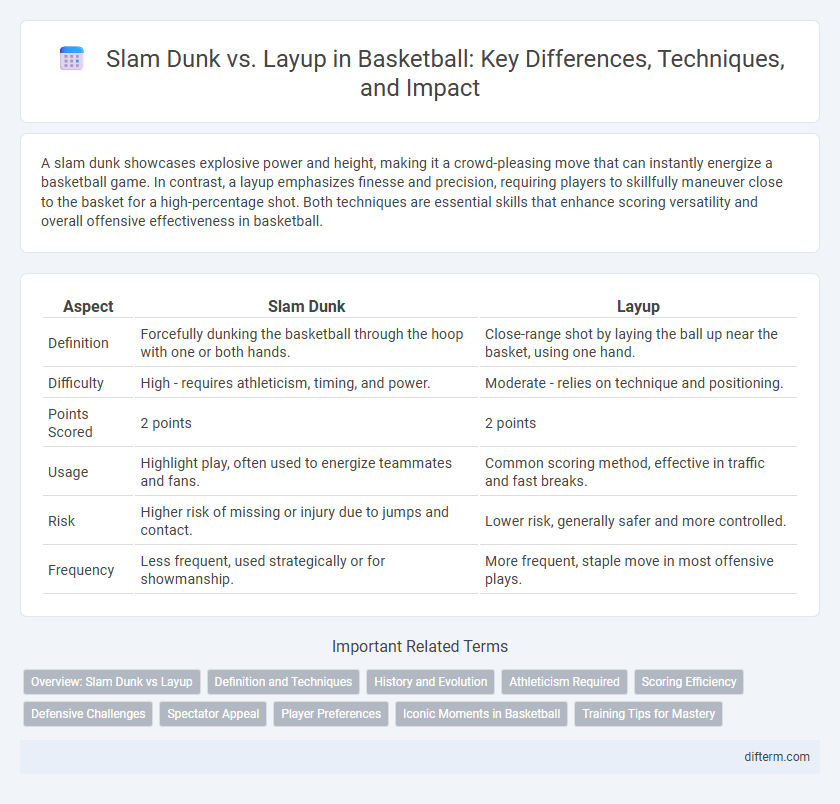A slam dunk showcases explosive power and height, making it a crowd-pleasing move that can instantly energize a basketball game. In contrast, a layup emphasizes finesse and precision, requiring players to skillfully maneuver close to the basket for a high-percentage shot. Both techniques are essential skills that enhance scoring versatility and overall offensive effectiveness in basketball.
Table of Comparison
| Aspect | Slam Dunk | Layup |
|---|---|---|
| Definition | Forcefully dunking the basketball through the hoop with one or both hands. | Close-range shot by laying the ball up near the basket, using one hand. |
| Difficulty | High - requires athleticism, timing, and power. | Moderate - relies on technique and positioning. |
| Points Scored | 2 points | 2 points |
| Usage | Highlight play, often used to energize teammates and fans. | Common scoring method, effective in traffic and fast breaks. |
| Risk | Higher risk of missing or injury due to jumps and contact. | Lower risk, generally safer and more controlled. |
| Frequency | Less frequent, used strategically or for showmanship. | More frequent, staple move in most offensive plays. |
Overview: Slam Dunk vs Layup
A slam dunk delivers maximum impact by forcefully thrusting the ball through the hoop, showcasing athleticism and power, while a layup emphasizes finesse and precision by gently guiding the ball off the backboard into the basket. Slam dunks typically generate higher crowd excitement and can shift game momentum, whereas layups are fundamental scoring moves essential for maintaining consistent offensive flow. Both techniques require different skill sets, with dunks demanding explosive vertical leap and layups relying on control and timing near the rim.
Definition and Techniques
A slam dunk is a high-impact basketball move where the player forcefully thrusts the ball down through the hoop with one or both hands, emphasizing power and vertical leap. A layup requires close proximity to the basket, involving a smooth, one-handed shot off the backboard that prioritizes precision and body control. Mastery of a slam dunk depends on explosive strength and timing, while an effective layup relies on agility and finesse in maneuvering around defenders.
History and Evolution
Slam dunks emerged as a powerful basketball move in the 1960s, popularized by players like Julius Erving, transforming the game's athleticism and entertainment value. Layups, existing since basketball's inception in 1891 by James Naismith, have remained a fundamental scoring technique due to their efficiency and consistency. The evolution of slam dunks showcases innovations in player vertical leap and style, while layups continue to adapt through varied finger rolls and floaters, maintaining their status in modern gameplay.
Athleticism Required
A slam dunk demands exceptional vertical leap, explosive power, and upper body strength to elevate and forcefully score above the rim. In contrast, a layup requires agility, precision, and smooth coordination to navigate defenders and softly place the ball off the backboard. Both techniques showcase different facets of basketball athleticism, emphasizing power versus finesse.
Scoring Efficiency
Slam dunks have a higher success rate due to their close proximity to the hoop and the force behind the shot, resulting in near-certain points. Layups, while slightly less forceful, offer versatility and quicker execution, often leading to a higher volume of scoring opportunities. Both techniques are essential for maximizing scoring efficiency depending on defensive pressure and player positioning.
Defensive Challenges
Slam dunks present significant defensive challenges due to their power and elevation, often overwhelming defenders trying to block or contest the shot. Layups require defenders to maintain close positioning and quick reflexes to prevent easy conversions in traffic or on the drive. Defensive strategies must adapt to the explosive nature of slam dunks while controlling the precision and finesse involved in layups.
Spectator Appeal
Slam dunks captivate spectators with their high-flying athleticism and explosive power, often turning the momentum of the game and eliciting loud crowd reactions. In contrast, layups showcase precision and finesse, appealing to fans who appreciate skillful, controlled plays under pressure. While both moves are fundamental, slam dunks tend to generate greater excitement and visual impact for audiences in arena settings.
Player Preferences
Players often prefer slam dunks for their high-impact visual appeal and confidence boost during crucial moments, while layups are favored for their reliability and higher success rate in close-range scoring. Many athletes choose slam dunks to energize the team and crowd, enhancing momentum, whereas layups provide consistent points with minimal risk of turnovers. The decision between these shots depends on game situation, player skill set, and defensive pressure.
Iconic Moments in Basketball
Michael Jordan's iconic slam dunk from the free-throw line during the 1988 Slam Dunk Contest became a defining moment in basketball history, symbolizing athleticism and creativity. In contrast, layups have produced legendary plays like LeBron James' chase-down block and subsequent layup in the 2016 NBA Finals, showcasing precision and clutch performance. Both slam dunks and layups continue to shape memorable highlights that captivate fans and influence the evolution of the sport.
Training Tips for Mastery
Mastering the slam dunk requires explosive leg strength, vertical jump drills, and upper body conditioning to generate power and control. Layup proficiency depends on agility, footwork precision, and hand-eye coordination practiced through repetitive close-range shooting drills. Incorporate plyometrics, balance exercises, and simulated in-game scenarios to develop a reliable dunk and an accurate, efficient layup.
slam dunk vs layup Infographic

 difterm.com
difterm.com